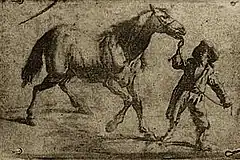Heliography
Heliography (in French, héliographie) from helios (Greek: ἥλιος), meaning "sun", and graphein (γράφειν), "writing") is the photographic process invented by Joseph Nicéphore Niépce around 1822,[1] which he used to make the earliest known surviving photograph from nature, View from the Window at Le Gras (1826 or 1827), and the first realisation of photoresist[2] as means to reproduce artworks through inventions of photolithography and photogravure.

Invention

Niépce prepared a synopsis of his experiments in November 1829: On Heliography, or a method of automatically fixing by the action of light the image formed in the camera obscura[3][4] which outlines his intention to use his “Heliographic” method of photogravure or photolithography as a means of making lithographic, intaglio or relief master plates for multiple printed reproductions.[5]
He knew that the acid-resistant Bitumen of Judea used in etching hardened with exposure to light.[6] In experiments he coated it on plates of glass, zinc, copper and silver-surfaced copper, pewter and lithographic stone,[7] and found it resisted dissolution[8] in oil of lavender and petroleum, so that the uncoated shadow areas could be traditionally treated through acid etching and aquatint to print black ink.[9][10]
The exposed and solvent-treated plate itself, as in the case of View from the Window at Le Gras, presents a negative or positive image dependent upon ambient reflection, not unlike the daguerreotype which was based on Niépce's discoveries.
Chemistry
Bitumen has a complex and varied structure of polycyclic aromatic hydrocarbons (linked benzene rings), containing a small proportion of nitrogen and sulphur; its hardening in proportion to its exposure to light is understood to be due to further cross-linking of the rings, as is the hardening of tree resins (colophony, or abietic acid) by light, first noted by Jean Senebier in 1782. The photochemistry of these processes, which has been studied by Jean-Louis Marignier of Université Paris-Sud since the 1990s,[11][12][13] is still to be fully understood.[14]
Alternative meanings
The word has also been used to refer to other phenomena: for description of the sun (cf. geography), for photography in general, for signalling by heliograph (a device less commonly called a heliotrope or helio-telegraph), and for photography of the sun.[15]
The abbreviations héliog. or héliogr., found on old reproductions, may stand for the French word héliogravure, and can then refer to any form of photogravure.
References
- "The First Photograph — Heliography". Archived from the original on 2009-10-06. Retrieved 2009-09-29.
from Helmut Gernsheim's article, "The 150th Anniversary of Photography," in History of Photography, Vol. I, No. 1, January 1977: ...In 1822, Niépce coated a glass plate... The sunlight passing through... This first permanent example... was destroyed... some years later.
- Dyson, R. W. (Robert William), 1942- (1987), Specialty polymers, Blackie ; New York : Chapman and Hall, p. 102, ISBN 978-0-412-01551-9CS1 maint: multiple names: authors list (link)
- Bonnet, M., & Marignier, J.-L. (2003). Niépce, correspondance et papiers. Saint-Loup-de-Varennes: Maison Nicéphore Niepce
- "Niépce Correspondance et papiers, accessible en ligne". Musée Photo Maison Nicéphore Niépce (in French). 2012-01-09. Retrieved 2019-08-23.
- Ostroff, E. (1969). 'Etching, Engraving & Photography: History of Photomechanical Reproduction.' In The Journal of Photographic Science, 17(3), 65-80.
- Vogel, Hermann Wilhelm (1876). The chemistry of light and photography in their application to art, science, and industry (revised ed.). H. King. p. 12.
- Michael Peres (2007), The Concise Focal Encyclopedia of Photography From the First Photo on Paper to the Digital RevolutionPaperback (1st ed.), Focal Press, p. 85, ISBN 978-0-240-80998-4
- M. Hepher (Fellow) (1964) The Third Fishenden Memorial Lecture: The Photo-Resist Story—From NiéPce to the Modern Polymer Chemist, The Journal of Photographic Science, 12:4, 181-190, DOI: 10.1080/00223638.1964.11737246
- Krongauz, V. V. (Vadim V.), 1953-; Trifunac, A. D. (Alexander D.), 1944- (1995), Processes in photoreactive polymers, Chapman & Hall, ISBN 978-0-412-98401-3CS1 maint: multiple names: authors list (link)
- Morrish, David; MacCallum, Marlene, (author.) (2015), Copper plate photogravure : demystifying the process, Focal Press, ISBN 978-1-138-13124-8CS1 maint: multiple names: authors list (link)
- Marignier, Jean-Louis. "L'invention de la photographie." Comptes Rendus de l'Académie des Sciences-Series IIB-Mechanics-Physics-Chemistry-Astronomy 325.7 (1997): 415-420.
- MARIGNIER, Jean-Louis (1998). "L'invention de la photographie par Nicéphore Niépce : apport de la voie expérimentale". www.openbibart.fr. Retrieved 2019-08-23.
- Marignier, J. L. (2003). Niepce: l'invention de la photographie. Belin, Paris.
- Hannavy, J. (2008). Encyclopedia of nineteenth-century photography. New York: Routledge.
- Descriptions of the sun, photography in general, and signalling by heliotrope: Oxford English Dictionary 2nd ed. (1989) s.v. "Heliography". Photography of the sun: As used by and in discussion of Hiroshi Yamazaki.
Other Sources
- Art & Architecture Thesaurus, s.v. "heliography". Accessed 10 December 2007.
- Harry Ransom Center. The University of Texas at Austin. The First Photograph. Accessed 10 December 2007.
- An Improved Method in the Art of Signalling for Military & Scientific Purposes (1887). Accessed 1 June 2008.